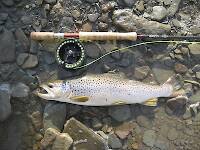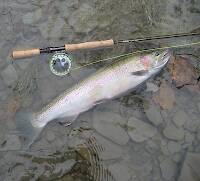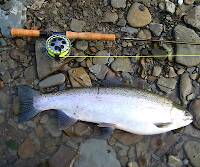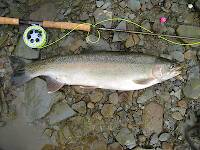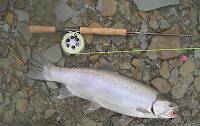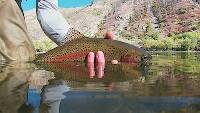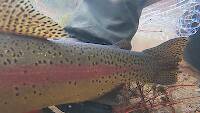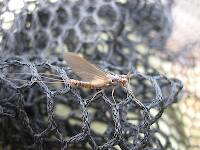
Hex Mayflies
Hexagenia limbata
The famous nocturnal Hex hatch of the Midwest (and a few other lucky locations) stirs to the surface mythically large brown trout that only touch streamers for the rest of the year.
Featured on the forum

This one was surprisingly straightforward to identify. The lack of a sclerite at the base of the lateral hump narrows the field quite a bit, and the other options followed fairly obvious characteristics to Clostoeca, which only has one species, Clostoeca disjuncta.

Troutnut is a project started in 2003 by salmonid ecologist Jason "Troutnut" Neuswanger to help anglers and
fly tyers unabashedly embrace the entomological side of the sport. Learn more about Troutnut or
support the project for an enhanced experience here.
CaseyP on Mar 20, 2008March 20th, 2008, 2:42 pm EDT
now i know why some fly anglers don't/won't use streamers: on Wednesday i wasted two fish that inhaled my mini buggers so deeply i couldn't remove them. the three fish that bit the bhpt were hooked every so delicately in the lip and we parted company quickly and painlessly, but the two for whom i dredged a small streamer weren't so lucky. i stopped fishing after the second.
what can i do to prevent this? in the case of bluegills, i just use a great big fly so they can't swallow it down so far, but trout?
what can i do to prevent this? in the case of bluegills, i just use a great big fly so they can't swallow it down so far, but trout?
"You can observe a lot by watching." Yogi Berra
Wbranch on Mar 20, 2008March 20th, 2008, 4:07 pm EDT
Are you fishing barbless? Often trout are chasing yhe streamer so agressively they do get hooked deep into the mouth or even near the gills. If you are barbless the hook should come out easily but you will still kill an occassional fish.
Catskill fly fisher for fifty-five years.
Chris_3g
Posts: 59
Posts: 59
Chris_3g on Mar 21, 2008March 21st, 2008, 12:53 am EDT
Casey,
This isn't much help, but I understand where you're coming from. I posted a while back about accidentally hooking up with juvenile trout with flies that were a bit too big, and these were #10 or #12 scud hooks. While I don't know that I killed them, I didn't do them any good.
I've had flies inhaled before by a few types of fish, trout included, and I've resigned myself to not working too hard at getting the hook out. Rather, I clip the line, release the fish, and hope for the best. I tend to assume that I will do more damage rummaging around the trout's mouth / throat vs. getting him / her back in the water quickly. I know the hooks dissolve if they're left in the fish, but unfortunately, I don't know how quickly (or productive) this process is if the hook is too far down the fish's throat.
I think it's just the nature of the beast, but de-barbing the hook, as Matt suggested, has helped me out a lot in this arena.
Chris.
This isn't much help, but I understand where you're coming from. I posted a while back about accidentally hooking up with juvenile trout with flies that were a bit too big, and these were #10 or #12 scud hooks. While I don't know that I killed them, I didn't do them any good.
I've had flies inhaled before by a few types of fish, trout included, and I've resigned myself to not working too hard at getting the hook out. Rather, I clip the line, release the fish, and hope for the best. I tend to assume that I will do more damage rummaging around the trout's mouth / throat vs. getting him / her back in the water quickly. I know the hooks dissolve if they're left in the fish, but unfortunately, I don't know how quickly (or productive) this process is if the hook is too far down the fish's throat.
I think it's just the nature of the beast, but de-barbing the hook, as Matt suggested, has helped me out a lot in this arena.
Chris.
JAD on Mar 21, 2008March 21st, 2008, 1:29 am EDT
Hi Casey
I think thats part of fishing, I seem to kill more fish on beetles. I'm not sure it has to do about size, more how aggressive the fish are IMHO
John
I think thats part of fishing, I seem to kill more fish on beetles. I'm not sure it has to do about size, more how aggressive the fish are IMHO
John
They fasten red (crimson red) wool around a hook, and fix onto the wool two feathers which grow under a cock’s wattles, and which in colour are like wax.
Radcliffe's Fishing from the Earliest Times,
Wbranch on Mar 21, 2008March 21st, 2008, 1:46 am EDT
I know it is a cliche but fishing is always going to be a blood sport.
We can only try our best to do as little harm as possible. If you really want to protect the trout yet still enjoy the pursuit, presentation, line management, etc just get a pair of diagonals and cut through the hook right at the start of the bend. Then you'll still feel the strike, or see the rise, but you won't be hooking, or hurting, them.
We can only try our best to do as little harm as possible. If you really want to protect the trout yet still enjoy the pursuit, presentation, line management, etc just get a pair of diagonals and cut through the hook right at the start of the bend. Then you'll still feel the strike, or see the rise, but you won't be hooking, or hurting, them.
Catskill fly fisher for fifty-five years.
CaseyP on Mar 21, 2008March 21st, 2008, 5:09 am EDT
barbless, yes.
cut the line off, yes.
give up sooner trying to get the hook out--good idea.
cut the sharp part off--that was mentioned last year in a neat thread about "missed strikes" because of the possibility of counting fish we might otherwise not have landed. sounds pretty refined!
thanks for the suggestions, everyone. i guess the winter's daydreams didn't prepare me for the occasional disaster--odd how one's mind can shut out the dark side of an activity. i'll take the longer hemos today--and more smaller flies.
cut the line off, yes.
give up sooner trying to get the hook out--good idea.
cut the sharp part off--that was mentioned last year in a neat thread about "missed strikes" because of the possibility of counting fish we might otherwise not have landed. sounds pretty refined!
thanks for the suggestions, everyone. i guess the winter's daydreams didn't prepare me for the occasional disaster--odd how one's mind can shut out the dark side of an activity. i'll take the longer hemos today--and more smaller flies.
"You can observe a lot by watching." Yogi Berra
Wbranch on Mar 21, 2008March 21st, 2008, 7:49 am EDT
Native Americans didn't feel it was always necessary to kill an opponent in battle. If they merely touched the enemy, and survived, they felt they had proven their manliness. It was called "counting coup".
The method I described is derived from "counting coup".
The method I described is derived from "counting coup".
Catskill fly fisher for fifty-five years.
JAD on Mar 21, 2008March 21st, 2008, 7:55 am EDT
That reminds me when I was a boy. We would tie string to grass-hopper and feed to small bass, they would fight like the dickens and out popped the hopper. Mind you one had to wait long enough for the bass to swallow the hopper.( seemed like a hour) :)
John
John
They fasten red (crimson red) wool around a hook, and fix onto the wool two feathers which grow under a cock’s wattles, and which in colour are like wax.
Radcliffe's Fishing from the Earliest Times,
Wbranch on Mar 21, 2008March 21st, 2008, 11:19 am EDT
Jad,
That is a really cool story! When I was a young fly fisher, I mean like fifty two years ago!!! My buddy and I drove to PA as at that time I lived in NJ. Well anyway we wound up wanting to go fish the Brodheads near Mountain Top I think the town was called. We'd seen an article in Field & Stream. Well we hammered the browns in the very short public water stretch of river and we met another young guy like us and he told us he would take us to his house to get something cold to drink and then he would show us how to catch trout with his bare hands.
We were thinking like yea sure you can. But he took us to a very narrow little trickle, I wouldn't even call it a creek, it was no more than six feet wide and the deepest "pool" was maybe a foot. He would find a spot in the water with a couple of rocks that were leaning up against each other and he would put one hand at one end of the rocks and with his other hand he would insert it into the opening between the rocks and feel around for a fish. If he found one he would tell us to put our hands at the back end and he would then use both hands to get in between the rocks and extricate the prettiest looking wild brown trout that I had ever seen at that time.
They were not midgets either - as I remember them none were less than 10" and a couple were 12" long. It was the neatest trick I had ever seen. But he told us that besides trout he had also gotten hold of eels, water snakes, and a a couple of turtles had bitten him so I never had enough courage to try it myself.
That is a really cool story! When I was a young fly fisher, I mean like fifty two years ago!!! My buddy and I drove to PA as at that time I lived in NJ. Well anyway we wound up wanting to go fish the Brodheads near Mountain Top I think the town was called. We'd seen an article in Field & Stream. Well we hammered the browns in the very short public water stretch of river and we met another young guy like us and he told us he would take us to his house to get something cold to drink and then he would show us how to catch trout with his bare hands.
We were thinking like yea sure you can. But he took us to a very narrow little trickle, I wouldn't even call it a creek, it was no more than six feet wide and the deepest "pool" was maybe a foot. He would find a spot in the water with a couple of rocks that were leaning up against each other and he would put one hand at one end of the rocks and with his other hand he would insert it into the opening between the rocks and feel around for a fish. If he found one he would tell us to put our hands at the back end and he would then use both hands to get in between the rocks and extricate the prettiest looking wild brown trout that I had ever seen at that time.
They were not midgets either - as I remember them none were less than 10" and a couple were 12" long. It was the neatest trick I had ever seen. But he told us that besides trout he had also gotten hold of eels, water snakes, and a a couple of turtles had bitten him so I never had enough courage to try it myself.
Catskill fly fisher for fifty-five years.
JAD on Mar 21, 2008March 21st, 2008, 11:36 am EDT
I'll bet it would be neat to talk to him now-you know he"s a old man now like you and I.
Sorry about the Hi Jack
John
They fasten red (crimson red) wool around a hook, and fix onto the wool two feathers which grow under a cock’s wattles, and which in colour are like wax.
Radcliffe's Fishing from the Earliest Times,
Quick Reply
Related Discussions
Topic
Replies
Last Reply
4
Jul 25, 2019
by Iasgair
by Iasgair
Re: if bass and carp are o.k., what about tarpon and permit? Featured Topic


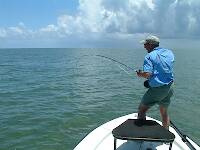
In the Photography Board by Gutcutter



In the Photography Board by Gutcutter
4
Feb 24, 2010
by Gutcutter
by Gutcutter





